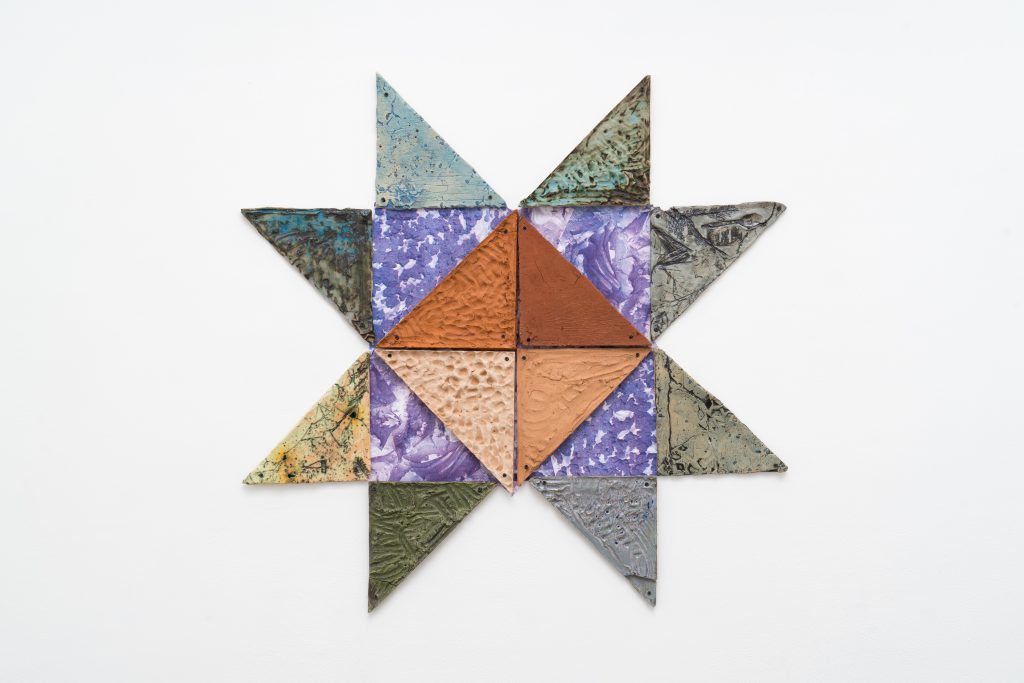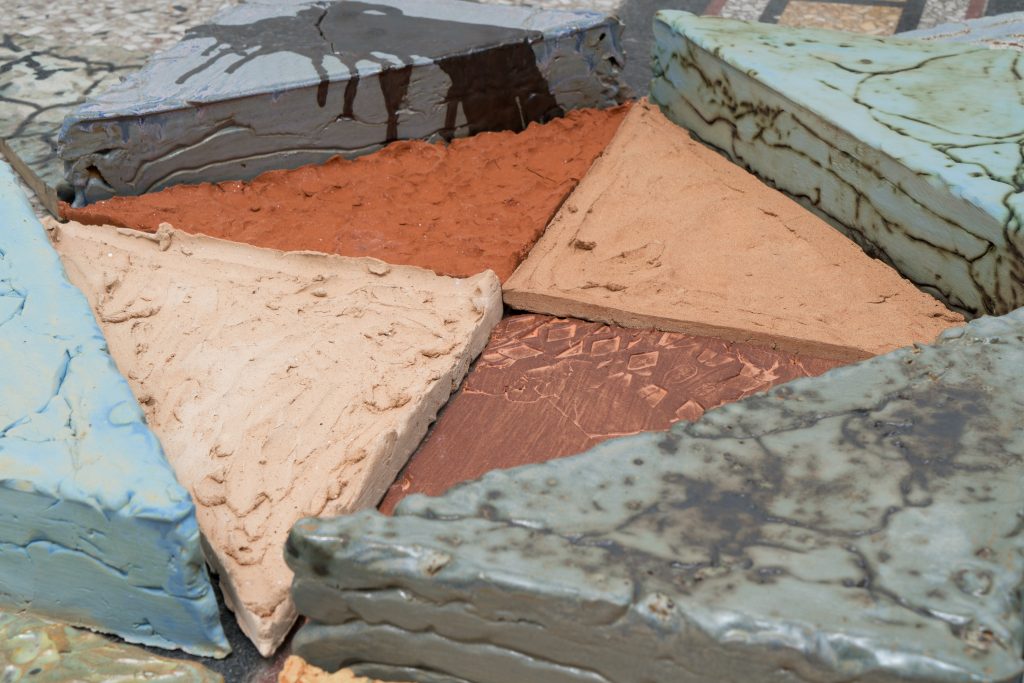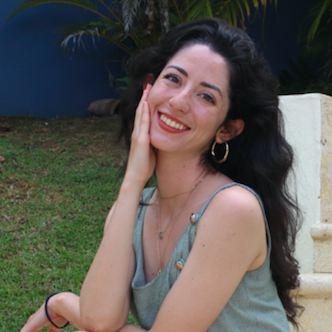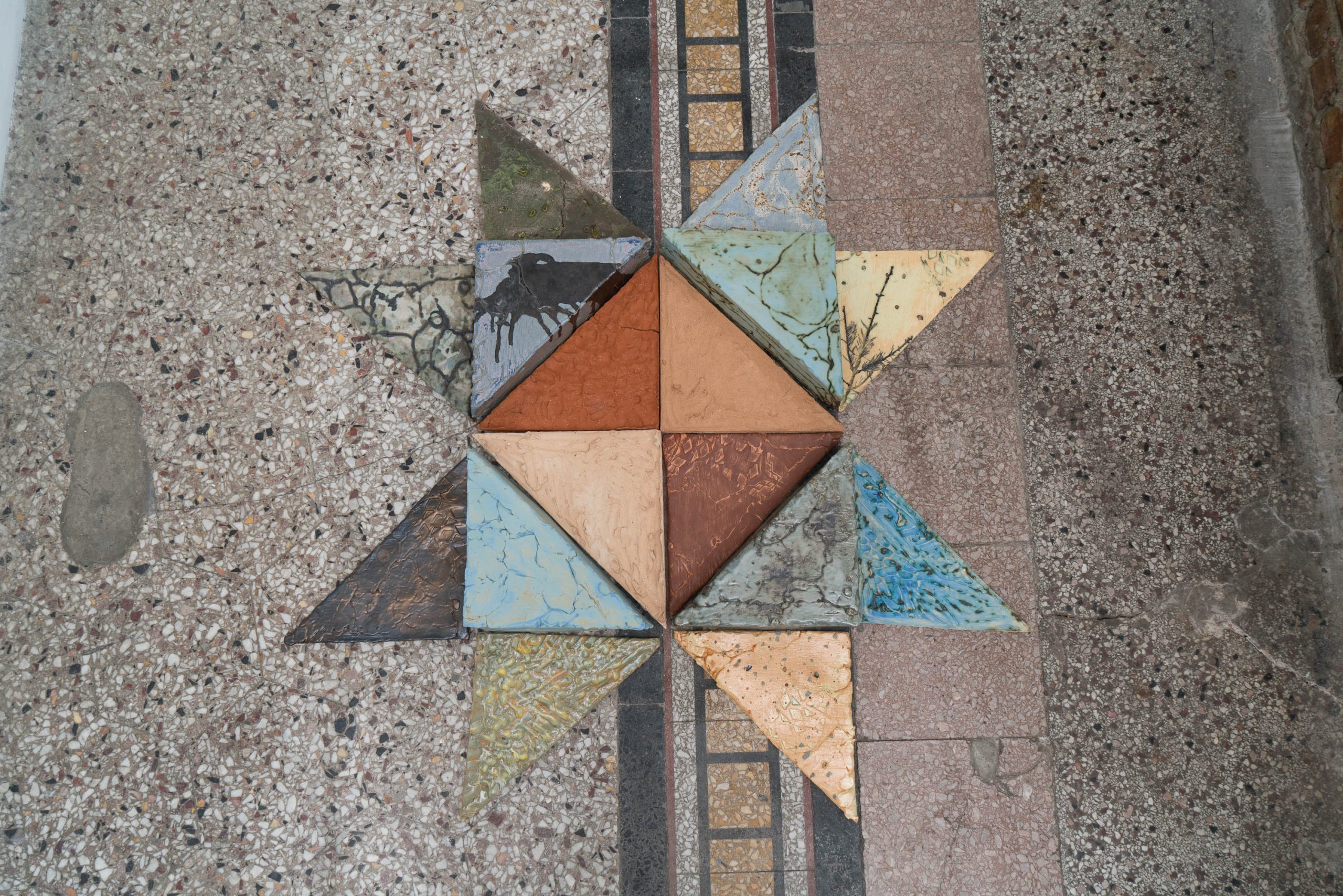E. Saffronia Downing’s artistic process is inextricably woven with her practice as a walker. It’s on her walks and hikes that she is able to locate and extract the clay she forages that forms the base of her ceramic work. Downing’s sculpture Compass Sampler, most recently on view at Roots and Culture Contemporary Art Center as part of the show Flattened Flora: A Compass Sampler, is composed of different ceramic tiles made of materials foraged from the Kennebec River in Maine, Hartford Road in Baltimore, the Kickapoo River in Wisconsin, and the Palos Preserves in Chicago. The individual ceramic tiles are arranged to form a unified block with each corner pointing in a different direction. Each clay piece, shaped in a 90-degree triangle, is distinct in color and pattern, some have noticeable fingerprints, and others are encrusted with herbs. Downing arranges the ceramic tiles in a way that they form a starburst or, as the beautiful accompanying text by Rosemary Holliday Hall at Roots and Culture describes, “flattened flora.”

Compass Sampler speaks to an extensive process of site-specific research on interrelated industrial and environmental histories. During her various walks throughout the city, Downing became interested in the clay she found in her Chicago neighborhood. The foraged material was full of heavy metals that were geologic as well as industrial residue from paint and pipes. To create the materials used in the sculpture, Downing sifted through sediment in rivers and preserves, finding organic material mixed in with residue from construction sites and other local sites of material extraction. The ceramic works that form the coordinates of Compass Sampler are pressed down in the same process used to create bricks, drawing inspiration from her research into the prominence of Chicago’s brickmaking industry.
Downing’s ceramic works are notably textured with unique details on each tile. The undulated ridges in the ceramic work highlight her process of flattening and condensing the clay. During her time in Chicago, Downing continued experimenting with this brick-making-inspired process in her series Tablets, which incorporated trash she gathered on her walks that she burrowed inside the clay structure. Peeking out on the surface of the ceramic works are detailed impressions of pull taps, bottle tops, and straws. The trace of industrial and consumer matter offers a commentary on anthropocentric time, from the geological moment when humans have inhabited the Earth, to the speeding up the Earth’s slow gradual movements to catch up with the rapid change of human time. This change is a sort of flattening in its own right, a condensing and pressurizing of a movement of rock matter that has, with the exception of notable catastrophes, been gradual and imperceptible to the lifespan of most beings.

Compass Sampler also draws inspiration from the tile work in quilts. The reference to textile work literally and metaphorically speaks to the work’s exploration of interwovenness and Downing’s own interest in entanglement theory which notes that when two particles become entangled, even when separated by vast distances they can remain connected. Theories of entanglement and interwovenness, likewise, not only connect the various sites from which clay was foraged for this work but additionally speak to how the violence of extraction permeates human’s continual engagement with earth matter.
Macarena Gómez-Barris in her book The Extractive Zone importantly underscores that extractivism is not just an action but a knowledge system. What Gómez-Barris refers to as the extractive zone is a “colonial paradigm, worldview, and technologies that mark out regions of “high biodiversity” in order to reduce life to capitalist resource conversion.”[1] Walter Mignolo in his accounts of undoing modernity notes that in order to move beyond this system of extraction we must find ways to think beyond this “epistemological hegemony”[2] and create new narratives and stories. Compass Sampler then invites the question; if extraction is not just an act but a hegemonic system of knowledge that justifies viewing the earth as quantifiable, usable, and exploitable, what then can the fracture, the rupture, the fissure offer us?
Downing’s reconfigurations of clay point towards a relationship to earth matter that can be rooted in a momentary encounter of attention and awareness. It is a ceramic work that foregrounds its relationship to earth matter and, as a result, wrestles with the dynamics of extraction noting, in some ways, that there is no way to be non-extractive during an extractive moment. However, in equal measure, Downings’s process, like walking, is itinerant, continually moving, shifting, changing, and open to emergence. It contends with the impressions of industry and, simultaneously, leaves room for the tactile and tender exchange of a present encounter.
* * *
Works Cited
- Gómez-Barris, Macarena. The Extractive Zone : Social Ecologies and Decolonial Perspectives. Durham: Duke University Press, 2018. Print, xvi.
- Mignolo, Walter. The Darker Side of Western Modernity Global Futures, Decolonial Options. Durham: Duke University Press, 2011, 80.

Alexandra Méndez (she/her/ella) is an art historian, writer, and educator from San Juan, Puerto Rico. She has an MA from the University of Texas at Austin in Art History. Her research focuses on contemporary art from Puerto Rico that engages with ecological subject matter. Currently she is the Linde Family Foundation Coordinator of Academic Access at the Colby College Museum of Art.



